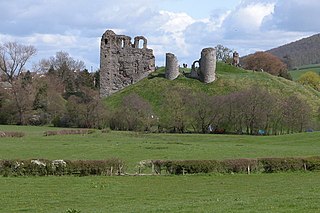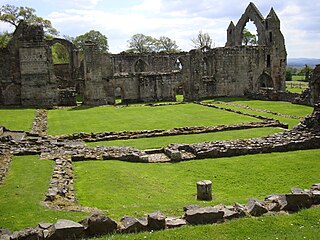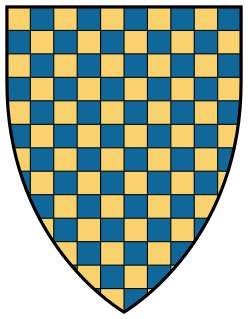
William de Braose, 3rd Lord of Bramber was a 12th-century Marcher lord who secured a foundation for the dominant position later held by the Braose family in the Welsh Marches. In addition to the family's English holdings in Sussex and Devon, William had inherited Radnor and Builth, in Wales, from his father Philip. By his marriage he increased the Braose Welsh holdings to include Brecon and Abergavenny.
John FitzAlan (1223–1267), Lord of Oswestry and Clun, and de jure matrisEarl of Arundel, was a Breton-English nobleman and Marcher Lord with lands in the Welsh Marches.

Clun Castle is a ruined castle in the small town of Clun, Shropshire. Clun Castle was established by the Norman lord Robert de Say after the Norman invasion of England and went on to become an important Marcher lord castle in the 12th century, with an extensive castle-guard system. Owned for many years by the Fitzalan family, Clun played a key part in protecting the region from Welsh attack until it was gradually abandoned as a property in favour of the more luxurious Arundel Castle. The Fitzalans converted Clun Castle into a hunting lodge in the 14th century, complete with pleasure gardens, but by the 16th century the castle was largely ruined. Slighted in 1646 after the English Civil War, Clun remained in poor condition until renovation work in the 1890s.
John FitzAlan, 7th Earl of Arundel was an English nobleman. He was also feudal Lord of Clun and Oswestry in the Welsh Marches.

Haughmond Abbey is a ruined, medieval, Augustinian monastery a few miles from Shrewsbury, England. It was probably founded in the early 12th century and was closely associated with the FitzAlan family, who became Earls of Arundel, and some of their wealthier vassals and allies. It was a substantial, successful and wealthy house for most of its four centuries, although evidence of abuses appeared before its dissolution in 1539. The buildings fell into disrepair and the church was largely destroyed, although the remains of some of the domestic buildings remain impressive. The site is now in the care of English Heritage and is open to the public during the summer.
John FitzAlan, 3rd Lord of Clun and Oswestry (1200–1240) in the Welsh Marches in the county of Shropshire.
Walter Fitz Robert of Woodham Walter (c.1124–1198), lord of Little Dunmow, Essex, was steward under Stephen of England, having succeeded to that position upon the death of his father, Robert Fitz Richard. Walter died in 1198 and was buried at Little Dunmow, in the choir of the priory of Austin canons.
Alan fitz Flaad was a Breton knight, probably recruited as a mercenary by Henry I, in his conflicts with his brothers. After Henry became King of England, Alan became an assiduous courtier and obtained large estates in Norfolk, Sussex, Shropshire, and elsewhere in the Midlands, including the feudal barony and castle of Oswestry in Shropshire. His duties included supervision of the Welsh border. He is now noted as the progenitor of the FitzAlan family, the Earls of Arundel (1267–1580), and the House of Stuart, although his family connections were long a matter of conjecture and controversy.

FitzAlan is an English surname ultimately of Breton origin. In the aftermath of the Norman conquest of England a number of Breton nobles and knights settled in Britain. The FitzAlan family shared a common patrilinear ancestry with the Scots, and later English, royal dynasty, the House of Stuart. They are therefore also related to the current British royal family. They were descendants of the Breton knight Alan fitz Flaad grandson of the Seneschal of the Bishop of Dol. The FitzAlans held the earldom of Arundel during the period 1267 - 1580.
This is a list of Sheriffs and High Sheriffs of Shropshire
Reverend Robert William Eyton (1815–1881) was an English Church of England clergyman who was author of The Antiquities of Shropshire.
Isabella Mortimer, Lady of Clun and Oswestry was a noblewoman and a member of an important and powerful Welsh Marcher family. Although often overshadowed in modern historiography by her better-known parents, she is now known to have played an important part in her family's struggles against Llywelyn ap Gruffudd and to have helped to secure the frontline at Shropshire in the run-up to English conquest of Wales. She was the wife and widow of John III FitzAlan, baron of Clun and Oswestry and de jure earl of Arundel. After a lengthy widowhood, she married for a second time and largely disappeared from the records.
Robert de Say, also called Robert Fitz-Picot, was a Norman knight who arrived in Shropshire after the Norman invasion.
Henry de Say was a Norman nobleman who lived in Clun near Shrewsbury, along the medieval Welsh Marches. He inherited the important fortification Clun Castle from his father, Robert de Say, in 1098. Henry died some time after 1130. His son was Helias de Say.
Helias de Say, also called Hellias, was a Norman nobleman who lived in Clun near Shrewsbury, along the medieval Welsh Marches. He is believed to have inherited Clun Castle from his father, Henry de Say, in the reign of Henry I. Helias held the key fortification of Clun Castle during the years of the Anarchy. He was an important early benefactor of Haughmond Abbey. Upon his death, his only surviving child and heiress was Isabella de Say.
Isabella de Say (c.1132-1199) was an Anglo-Norman heiress. Isabella was the only surviving child of Helias de Say upon his death in 1165; Helias was the third lord of Clun, a powerful Norman stronghold in Shropshire, England, along the Welsh border. She was also a niece of the influential Robert, 1st Earl of Gloucester. She is notable for helping to create the powerful medieval house of the Fitz Allans. Isabella married William Fitz Alan, the lord of nearby Oswestry, as his second wife. William died in 1160, leaving a son by his first wife, Christiana, William Fitz Alan II. Isabella passed Clun Castle to him. The combined lordship of Oswestry and Clun was a significant power in the borderlands with Wales.
William FitzAlan (1105–1160) was a nobleman of Breton ancestry. He was a major landowner, a Marcher lord with large holdings in Shropshire, where he was the Lord of Oswestry, as well as in Norfolk and Sussex. He took the side of Empress Matilda during the Anarchy and underwent considerable hardship in the Angevin cause before regaining his lands and former status. William's younger brother, Walter fitz Alan, became ancestor of the royal House of Stuart.
William FitzAlan was a Norman nobleman who lived in Oswestry and Clun near Shrewsbury, along the medieval Welsh Marches. William was the son of William FitzAlan, controlling the castles of Clun and Oswestry and later became the High Sheriff of Shropshire. Many people today will often confuse William with his father, as their death dates are similar by 5 years. Because of this, it is important to know that this William was married to Mary Erington, the daughter of Thomas. William's father William married the daughter of Hugh de Lacy, whose name is never mentioned in any documents. When William came to inherit his lands in 1210, King John demanded a fee of 10,000 marks; unable to pay, William was unable to inherit. He only outlived his father by a few years, dying around Easter 1215. The estates were eventually reclaimed by his younger brother John Fitzalan.
William FitzAlan was a Norman nobleman who lived in Oswestry and Clun, near Shrewsbury, along the medieval Welsh Marches. William was the son of William FitzAlan and Christina.

The de Warenne family were a noble family in England that included the first Earls of Surrey, created by William the Conqueror in 1088 for William de Warenne, 1st Earl of Surrey, who was among his companions at the Battle of Hastings. The family originated in Normandy and as Earls, held land there and throughout England. When the senior male-line ended in the mid-12th century, the descendants of their heiress adopted the Warenne surname and continue as Earls of Surrey for another two centuries. Several junior lines also held land or prominent offices in England and Normandy.







